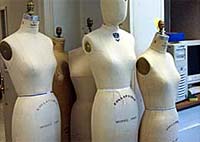Size
 Businesses in the apparel industry can also be categorized by the sizes of clothing they offer. Most small businesses start with one or two size classifications. This helps to focus the business for marketing as well as simplifies production and materials sourcing. Businesses do not always offer every size listed in the classifications below. The objective is to keep the number of stock keeping units (SKU's) small to simplify ordering and inventory for the apparel producer. Businesses in the apparel industry can also be categorized by the sizes of clothing they offer. Most small businesses start with one or two size classifications. This helps to focus the business for marketing as well as simplifies production and materials sourcing. Businesses do not always offer every size listed in the classifications below. The objective is to keep the number of stock keeping units (SKU's) small to simplify ordering and inventory for the apparel producer.
| Typical sizing classifications by product type |
Men's
|
|
|
Tailored
|
26-50 (chest), waist/inseam |
Regular, long, short |
Sportswear
|
S-M-L-XL or waist/inseam |
|
Furnishings (shirts, underwear, sweaters, sleepwear)
|
Neck/sleeve length or S-M-L-XL or waist sizes |
|
Active sportswear
|
S-M-L-XL-XXL |
|
Uniforms/Work
|
Waist/inseam, S-M-L-XL |
|
| |
|
|
| Women's Wear |
|
|
Missy
|
4-18 or S-M-L |
|
Women's or Plus sizes
|
16W-26W, 1X-4X |
|
Petite
|
2P-16P, under 5'4" |
|
Tall
|
10T-18T over 5'9" |
|
Junior
|
1-15 |
|
| |
|
|
Children's Wear
|
|
|
Infants
|
Weight/height or month (3,6,12,18) |
|
Toddler
|
2T-4T |
|
Boys
|
4-7, 8-20 |
Husky, Chubby |
Girls
|
4-6X, 7-16 |
|
Preteen (girls)
|
6-16 |
|
Young junior
|
3-13 |
|
The actual measurements of these size categories vary greatly across firms and even within firms across different product lines. Each firm uses its own "ideal figure" to create patterns based on a fit model. So, one firm's size 6 could be another firm's size 10. This is especially true for the women's wear category, where some businesses label their clothing with smaller sizes than measurements warrant, often known as vanity sizes.
|


 Businesses in the apparel industry can also be categorized by the sizes of clothing they offer. Most small businesses start with one or two size classifications. This helps to focus the business for marketing as well as simplifies production and materials sourcing. Businesses do not always offer every size listed in the classifications below. The objective is to keep the number of stock keeping units (SKU's) small to simplify ordering and inventory for the apparel producer.
Businesses in the apparel industry can also be categorized by the sizes of clothing they offer. Most small businesses start with one or two size classifications. This helps to focus the business for marketing as well as simplifies production and materials sourcing. Businesses do not always offer every size listed in the classifications below. The objective is to keep the number of stock keeping units (SKU's) small to simplify ordering and inventory for the apparel producer.